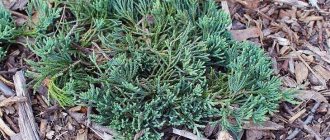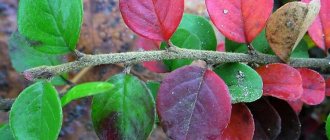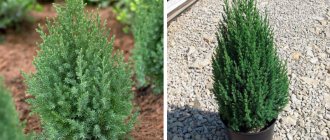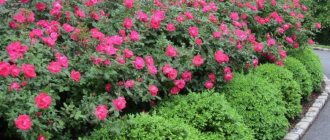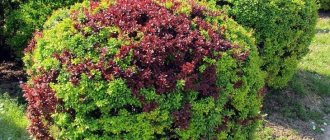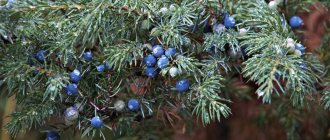Author: Elena N. https://floristics.info/ru/index.php?option=com_contact&view=contact&id=19 Category: Garden plants Published: February 25, 2019Last edits: November 04, 2020
Rock juniper (lat. Juniperus scopulorum) is a species of the Juniper genus of the Cypress family. Under natural conditions, rock juniper grows in the USA (Oregon, western Texas, northern Arizona), Canada (British Columbia and southwestern Alberta), and northern Mexico, choosing rocky mountain soils at an altitude of 1200 to 2700 meters above sea level. seas. In cultivation, rock juniper is still rare.
Planting and caring for rock juniper
- Planting: early spring, before sap flow begins.
- Lighting: bright sunlight.
- Soil: for dwarf varieties, poor soil is preferable; for large plants, fertile soil is preferable, in an area with deep groundwater.
- Watering: Young plants are watered regularly and abundantly, and adults - only during periods of prolonged drought; no more than three waterings are carried out in total during the season. In the evenings, in hot, dry weather, the juniper crown is sprayed with non-cold water once or twice a week.
- Fertilizing: in April-May, a solution of Nitrofoski or Kemira-universal is applied to the tree trunk area of young plants, but adult plants do not need fertilizing. Organic fertilizers are contraindicated for rock juniper.
- Pruning: the formation of the crown of rock juniper does not require, and sanitary pruning is carried out on a cloudy spring day before the sap begins to flow.
- Reproduction: semi-lignified cuttings, grafting or young layering.
- Pests: aphids, leafminer moths, spider mites and scale insects.
- Diseases: rust, tracheomycosis, fusarium wilt, drying out of branches, brown chute.
Read more about growing rock juniper below.
Insect pests
Among the harmful insects that attack juniper, you can encounter aphids, scale insects, and spider mites. And also mining moths. Fitoverm solution will help to cope with aphids. Using it, the entire bush is sprayed. When using, you must follow the instructions on the package.
Moths can be dealt with using Decis solution in the proportions specified in the instructions. To get rid of scale insects, dilute 70 grams of Karbofos in one bucket of water. And use it to cultivate the bush and the ground around it.
Spider mites can be controlled with acaricides.
Botanical description
Representatives of the species are dioecious trees or shrubs. The height of rock juniper can reach from 10 to 18 m with a trunk girth of 80 cm to 2 m, but in cultivation the plant is usually lower and thinner. The crown of the juniper starts almost from the base and has an irregular conical shape, which becomes rounded with age. The bark of the tree is brown, the shoots when young are bluish-green or light blue. Opposite, ovate-rhombic, mostly scale-like, up to 2 mm long and up to 1 mm wide, the leaves of rock juniper are colored bluish-green, dark green or blue-gray. The needle-shaped needles found on rock juniper reach a length of 12 and a width of 2 mm. Dark blue spherical cones with a blue bloom, 4 to 6 mm long, ripen by the end of the second year. The fruits contain reddish-brown ribbed seeds up to 5 mm in diameter.
Planting rock juniper
Rock juniper planting material with a closed root system can be planted in the ground during the entire growing season, but if the root system of the seedling is open, then the best time for planting is early spring, the period between the soil warming up and the start of sap flow.
Planting and caring for juniper in open ground
Planting rock juniper and caring for it will not be difficult if you follow the agrotechnical conditions of the crop. When choosing a place to plant a plant, you should prefer open sunny areas with deep groundwater. Large varieties are more suitable for fertile soil, while dwarf varieties grow better in poor soil, otherwise they cease to be stunted. It should also be taken into account that rock juniper needs a lot of space.
- Wintering figs in our cold climate - is it necessary to cover them?
The planting pit for rock juniper should be at least twice as large as the root system of the seedling. Dwarf varieties of plants are planted at intervals of half a meter, and the distance between seedlings of tall varieties should be at least 2 m: after 10 years the bush will begin to grow rapidly. A twenty-centimeter layer of broken brick or crushed stone is laid at the bottom of the planting pit. Before planting, it is advisable to immerse the roots of the seedling in a container of water for several hours: this will allow you to remove the plant from the container with minimal stress on it. If you manage to keep a ball of earth on the roots of the seedling when planting, it will be much easier for it to adapt to the new place.
Place the seedling in the hole, straighten its roots and fill the pit with a soil mixture of turf soil, peat and sand in a ratio of 1:2:1. After planting, the seedling should be watered abundantly, and when the water is absorbed, its tree trunk circle is mulched with a layer of sawdust, wood chips, pine bark or peat 8 cm thick. Please note that as a result of planting, the root collar of the seedling should be at ground level.
Caring for rock juniper
Growing in open ground
Rock juniper is undemanding in care and resistant to urban conditions, but it grows slowly, especially in the first years.
Watering an adult juniper is carried out only during periods of prolonged drought, no more than three times a season, but newly planted plants need more frequent watering. The seedlings also respond well to evening spraying with warm water.
As for fertilizers, organic matter is contraindicated for juniper, so for young plants in April-May one fertilizing with Nitroammophoska (30-40 g per m²) or Kemira-universal (20 g per 10 liters of water) will be enough. Mature plants do not need fertilizers.
The behavior of rock juniper in the cold season depends on the variety. Plants with a columnar crown after heavy snowfalls need to be shaken off from snow, under the weight of which their branches may break. To avoid such injuries, it is better to tie the branches with twine on the eve of snowfalls, pressing them to the trunk.
Transfer
Improper transplantation of juniper can lead to its death as a result of damage to the root system. Large adult specimens are especially affected. How to replant a plant correctly to avoid unpleasant consequences? When digging up juniper, it is extremely important to preserve the earthen ball in which the root system of the plant is located.
It is better to replant rock juniper during the period when it has maximum root-forming ability: in March-April or June-July. However, summer is not the best time for this procedure, because in the heat the needles evaporate too much water, which greatly weakens the plant and slows down the adaptation process. Based on this, the best time to replant rock juniper is spring, but if absolutely necessary, it can be replanted during leaf fall.
Growing Cossack juniper in open ground
First, dig a planting hole with the required parameters, taking into account the size of the earthen ball, and lay a drainage layer in the pit. Then prepare the soil mixture to fill the hole. And only after this they dig up the juniper in a circle, stepping back at least half a meter from its trunk, remove the plant with a lump of earth, lay it on a piece of dense film or fabric, transfer it to the planting hole and complete the process in the same order as during the initial planting. Don’t forget to mulch the tree trunk and protect the juniper from direct sunlight for the first time.
Pests and diseases of rock juniper
Most often, juniper is affected by rust, a fungal disease that is manifested by the formation of bright orange growths on the branches of the plant containing oil with a pigment close to carotene. A diseased plant loses its decorative appearance, its branches dry out and within a few years the juniper dies. When signs of rust appear, it is necessary to trim and destroy the affected branches and shoots, since they can no longer be cured, and the juniper should be treated with a fungicide. Do not forget to disinfect the tool before and after pruning. For preventive purposes, several treatments of juniper with fungicides should be carried out from spring to autumn. The best therapeutic and preventive effect was shown by the drugs Rogor, Bayleton, Vectra, Skor and Tilt.
Another common juniper disease is tracheomycosis, or fusarium wilt, which most often develops in too dense soil under conditions of high humidity. Tracheomycosis affects the root system of the juniper, and nutrition ceases to flow from the roots to the ground organs, as the fungal mycelium grows into the vascular system of the plant. As a result of the development of the disease, the apical shoots of the juniper begin to dry out, the needles of which acquire a reddish tint, and then the disease consumes the entire plant. It is almost impossible to detect tracheomycosis at an early stage, but as soon as you see that the rock juniper has turned yellow or red at the tops, cut off the affected branches, thoroughly treat the plant and the soil underneath with fungicides, but it is best to replace the top layer of soil in the trunk circle with fresh soil mixture , soaked in a fungicide solution. For preventive purposes, purchased planting material should be treated together with an earthen ball with Fitosporin-M, Quadris or Maxim, and the root system of smaller seedlings should be placed entirely in Maxim’s solution for 2-3 hours.
A serious disease of juniper is the drying out of branches, which leads not only to the loss of decorativeness, but also to the death of the plant: in the spring, the needles on rock juniper begin to turn yellow and fall off, first in small areas, and then the affected area increases and can cover the entire plant or a significant part of it. As the disease develops, small fruiting bodies of fungi appear on the needles and bark of the plant. Do not allow the disease to develop; immediately remove branches with yellowing needles, and then be sure to spray the juniper with a fungicide solution. But if the affected area is too large, it would be better to uproot the plant and burn it. Preventive treatments of juniper against drying out of branches are carried out twice: in the middle or end of April and at the end of October with Ridomil Gold MC, Tilt or Skor.
Brown schütte (the name of the disease comes from a German word meaning “to crumble”) is also manifested by yellowing, dying and falling of the needles. This process usually begins in early summer. At the end of August, black ellipsoidal fruiting bodies of fungi can be seen on the affected needles. The disease develops faster on junipers weakened by poor care, growing in the shade or in damp places. Branches with yellowing needles should be immediately pruned, fallen needles should be removed from under the plant, and the juniper should be treated with Quadris, Strobi, Ridomil Gold MC or Skor. For preventive purposes, such treatments are carried out twice a season: in mid-April and in the fall before frost.
- Brugmansia: growing in the garden, types and varieties
Among the pests for rock juniper, aphids, leafminer moths, spider mites and scale insects are dangerous. Aphids are destroyed by treating the plant with Fitoverm solution prepared in accordance with the instructions. To combat moths, use a solution of 2.5 g of the drug Decis in 10 liters of water, and the juniper scale insect is afraid of Karbofos: a solution of 70 g of the drug in 10 liters of water is sprayed on the plant and the soil under it. As for spider mites, an acaricide solution is used against them - Actellik, Karbofos, Aktara or other chemicals of similar action.
Juniper pruning
Since the crown of rock juniper initially has a certain shape, it does not need formative pruning. It only needs sanitary cleaning. How to prune rock juniper ? In early spring, before sap flow begins, on a cloudy day, the plant is freed from broken, dry, diseased and improperly growing branches and shoots. Since the annual growth of adult plants of this species is only 10 cm, cutting of rock juniper in order to even out the contours of the crown is carried out by no more than 2 cm.
Preparing for winter
Despite the fact that the plant is unpretentious, it is especially necessary to take care before the onset of winter. Therefore, Blue Arrow juniper especially requires care immediately after planting. They are usually planted in the spring; during the summer the plant adapts to its new place of residence. For the winter, cover the young tree or at least tie up the branches so that they do not break off under the weight of the snow.
READ Common spruce: description and types of spruce
With the arrival of spring, the shelter is removed and an inspection is carried out. Dead or broken branches must be removed. In other years, Virginia juniper Blue Arrow will not require pruning. If pruning is necessary, this must be done before the sap begins to appear.
Reproduction of rock juniper
This type of juniper propagates by cuttings, young layering or grafting. The upper semi-lignified shoots with a heel (a small piece of wood from the branch from which the shoot grows) are used as cuttings. For rooting, the cuttings are planted in a greenhouse, and when they develop a root system, they are transplanted to a training bed. The rooting time depends on the age of the cutting and the plant variety and ranges from one and a half to six months, and growing seedlings in a school is from three to six years.
Creeping forms of the species are propagated by layering: shoots stripped of needles are pinned to the prepared soil of the trunk circle, where they take root for six months or a year. Then they are separated and planted for growing in a training bed located in partial shade.
As for the propagation of juniper by grafting, the process is complex and requires professional skills.
more detailed instructions on how to propagate rock juniper by layering or cuttings in the article about Cossack juniper , which is already posted on our website.
Varietal diversity
Rock juniper is represented not by one variety, but by a dozen. Moreover, their external signs are so different that sometimes you won’t even think that they belong to the same coniferous crop.
Blue Arrow
The species got its name for a reason (translated as “blue arrow”): vertical branches growing from the very base, tightly pressed to the trunk and covered with rich bluish needles, form a crown that visually resembles the mentioned object. To some, the shape seems like a column. Both options have their place, as they accurately describe the appearance of the culture.
This type of juniper is one of the most stable and durable, as it has tough shoots that can withstand any unfavorable conditions, precipitation and temperature fluctuations.
"Blue Heaven"
The literal translation is “blue sky.” This species is especially popular among landscape designers due to its truly stunning bright blue needles, which remain that way all year round without changing a single shade. The needles themselves are of standard (medium) length, prickly and hard. Over the years they become scaly. The shoots grow quickly, forming a pin-shaped crown; the straight trunk is completely covered with branches.
The advantages of the variety are drought resistance, frost resistance, and unpretentiousness. Disadvantages - susceptible to rust diseases, does not tolerate polluted air well, not very strong branches often cannot withstand snow masses and break.
Sources:
https://sornyakov.net/trees/mozhzhevelnik-skalnyj.html https://fermer.blog/bok/hvoynye-derevya/mozhzhevelnik/vidy-mozhzhevelnika/mozhzhevelnik-skalnyy https://stroy-podskazka.ru/mozhzhevelnik/ sorta/skalnyj/
Varieties
American breeders have developed many varieties of rock juniper, and all of them are popular. We offer you an introduction to the varieties that grow best in our climate.
Rock juniper Blue Arrow is a variety with a height of 1.5 to 2.5 m with a narrow columnar crown up to 50 cm wide with scaly and needle-shaped blue-green needles with a steel tint.
Rock juniper Blue Haven is a variety about 2 m high with a pyramidal crown up to 1 m wide. The needles of this plant are steel-blue throughout the year.
Rock juniper Skyrocket - plants of this popular winter-hardy variety at the age of ten can reach a height of 3 to 6 m. The habit of Skyrocket is columnar - narrow and slender, the shoots are straight, adjacent to the trunk, the needles are mostly scaly, gray-green in color. The plant can be affected by fungal diseases.
Rock juniper Moffat Blue is a winter-hardy variety with a dense, wide-pyramidal crown and blue-green needles. This plant can reach a height of 3 to 6 m with a crown width of 1 to 1.3 m. This variety is not suitable for growing in humid climates.
Moonglow rock juniper is similar to the Blue Haven plant. At the age of 10 years, this wide-pyramidal juniper reaches a height of 2.5 m with a crown diameter of up to 1 m. The plant’s needles are an intense silver-blue color, which becomes even brighter in winter.
Silver King is a juniper with outstretched branches, reaching a height of 60 cm at the age of ten with a crown diameter of about 2 m. The needles are blue, mostly scaly.
Springbank is a light-loving juniper with a narrow columnar crown, reaching a height of 4 m. The ends of the shoots are shaggy, “disheveled”, the needles are thin, silver-blue in color.
- Tips for growing salvia in the garden
Table Top Blue is a juniper with an oval crown and silver-blue needles. At the age of 10 years, the plant reaches a height of 2 m with a crown width of up to 2.5 m.
Welch's rock juniper is a plant with a dense pyramidal crown and silver-blue-green needles.
Wichita Blue is a juniper with outstretched branches and silver-bluish needles, reaching a height of 40 cm by the age of 10 years with a crown diameter of 1.5 m.
In addition to those described, varieties of rock juniper Winter Blue, Tollesons Blue Whipin, Tollesons Green Whipin, Sutherland, Monwade, Medora, Greenspire, Erecta Glauka, Gray Glim, Colorado Green and many others are often grown in cultivation.
Rocky juniper in landscape design
In landscape design, rock juniper is used for single and group plantings in heather and rocky gardens, lining alleys, decorating small backyard gardens and as a vertical accent in flower arrangements.
Junipers with a clear and geometrically regular crown are effective both as a background for other plants and as a central link in a garden composition. This is an ideal choice for areas designed in Scandinavian and English styles, as well as for Japanese and Alpine gardens.
Where and how it grows, conditions
Rock juniper is most often found in Canada (British Columbia and southwestern Alberta), northern Mexico and the United States (northern Arizona, Oregon and western Texas). Juniper grows on rocky soil in the mountains, at an altitude of approximately 1200-2700 meters above sea level. This type of juniper is cultivated very rarely.
